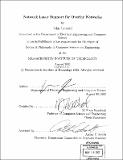| dc.contributor.advisor | M. Frans Kaashoek. | en_US |
| dc.contributor.author | Jannotti, John, 1974- | en_US |
| dc.contributor.other | Massachusetts Institute of Technology. Dept. of Electrical Engineering and Computer Science. | en_US |
| dc.date.accessioned | 2005-10-14T19:35:12Z | |
| dc.date.available | 2005-10-14T19:35:12Z | |
| dc.date.copyright | 2002 | en_US |
| dc.date.issued | 2002 | en_US |
| dc.identifier.uri | http://hdl.handle.net/1721.1/29274 | |
| dc.description | Thesis (Ph. D.)--Massachusetts Institute of Technology, Dept. of Electrical Engineering and Computer Science, 2002. | en_US |
| dc.description | Includes bibliographical references (p. 98-103). | en_US |
| dc.description.abstract | Overlay networks are virtual networks formed by cooperating nodes that share an underlying physical network. They represent a flexible and deployable approach for applications to obtain new network semantics without modification of the underlying network, but they suffer from efficiency concerns. This thesis presents two new primitives for implementation in the network layer (i.e., the routers of the physical network). These primitives support the efficient operation and construction of overlay networks. Packet Reflection allows end hosts to request that routers perform specialized routing and duplication for certain packets. Path Painting allows multiple end hosts to determine where their disparate paths to a rendezvous point meet, in order to facilitate overlay topology building that reflects the topology of the underlying network. Both primitives can be incrementally deployed for incremental benefit. This thesis describes a variety applications of these primitives: application level multicast systems with various semantics, an extended Internet Indirect Infrastructure with latency benefits over the original proposal, and an extension to Chord which would allows faster lookups. Experimental results on simulated topologies indicate that when all routers support the proposed primitives, less that 5% overhead (in terms of link usage and latency) remains in two common overlay network usage scenarios. In addition, the benefits gained from deployment are significant even at low deployment levels. At approximately 25% deployment, the primitives have reduced overhead by over 50%. When intelligent deployment strategies are used, link usage overhead is less than 30% at less than 10% deployment. Finally, the results indicate that these benefits affect the area local to the deployed routers, providing a deployment incentive to independent networks. | en_US |
| dc.description.statementofresponsibility | by John Jannotti. | en_US |
| dc.format.extent | 103 p. | en_US |
| dc.format.extent | 4124550 bytes | |
| dc.format.extent | 4124358 bytes | |
| dc.format.mimetype | application/pdf | |
| dc.format.mimetype | application/pdf | |
| dc.language.iso | eng | en_US |
| dc.publisher | Massachusetts Institute of Technology | en_US |
| dc.rights | M.I.T. theses are protected by copyright. They may be viewed from this source for any purpose, but reproduction or distribution in any format is prohibited without written permission. See provided URL for inquiries about permission. | en_US |
| dc.rights.uri | http://dspace.mit.edu/handle/1721.1/7582 | |
| dc.subject | Electrical Engineering and Computer Science. | en_US |
| dc.title | Network layer support for overlay networks | en_US |
| dc.type | Thesis | en_US |
| dc.description.degree | Ph.D. | en_US |
| dc.contributor.department | Massachusetts Institute of Technology. Department of Electrical Engineering and Computer Science | |
| dc.identifier.oclc | 52060525 | en_US |
